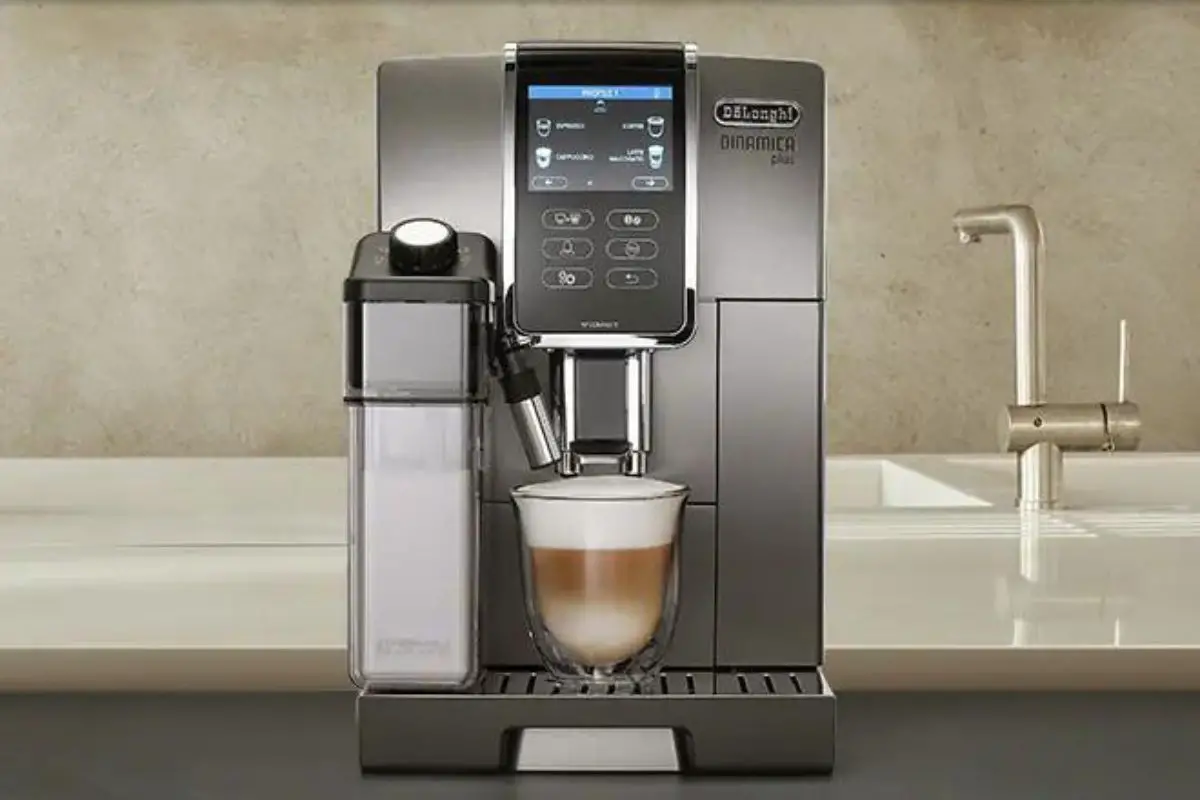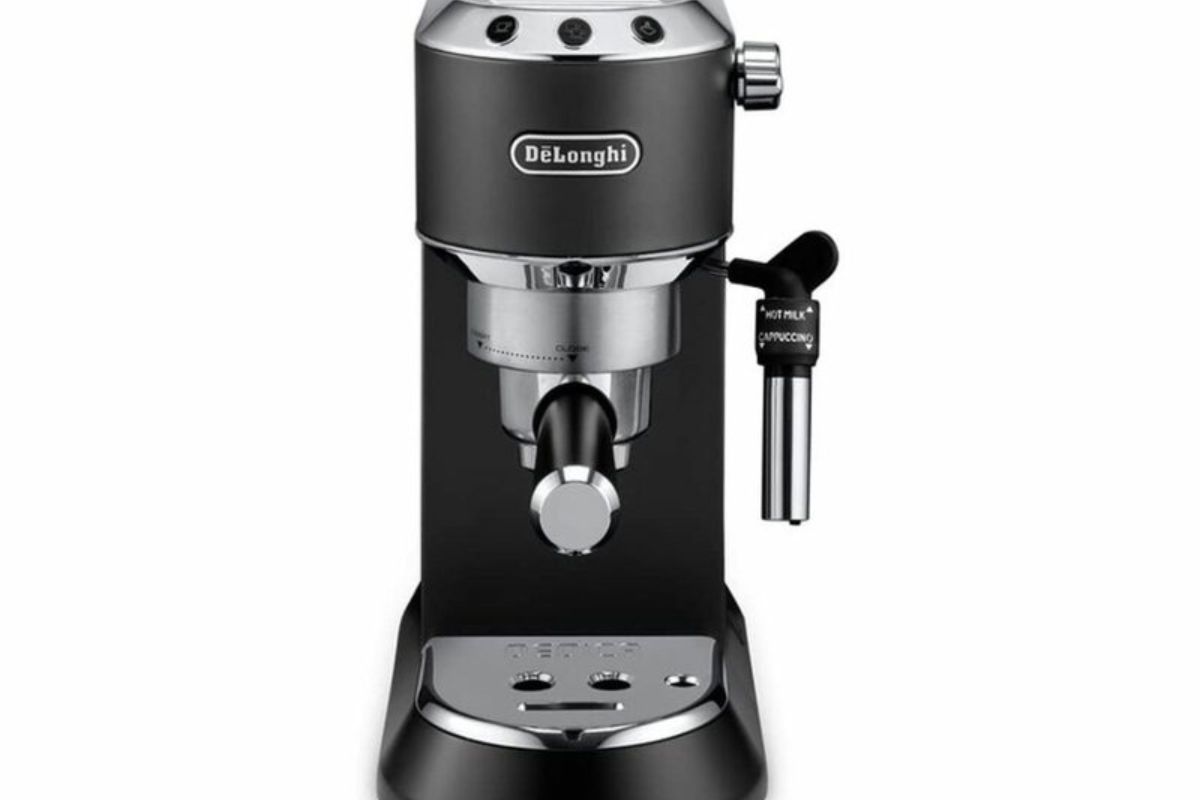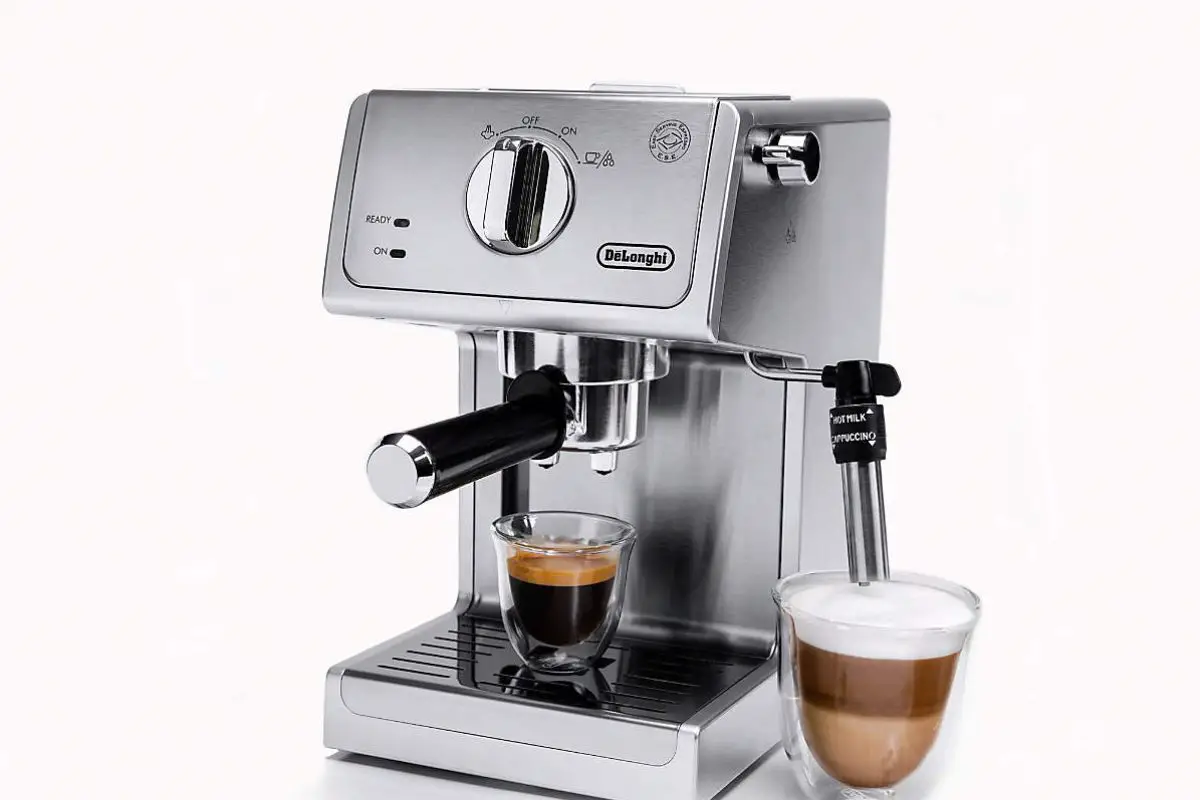Coffee machines are a delightful creation, providing us with the aromatic elixir that jumpstarts our mornings and keeps us going throughout the day. However, they can be temperamental beings, prone to occasional malfunctions and disturbances in their brewing process. Fear not, for in this article, we shall embark on a journey of troubleshooting the enigmatic Delonghi coffee machine.

With an objective and analytical approach, we shall delve into the common brewing issues that plague these machines and provide you with informative solutions. We shall unravel the mysteries of the grinder, decipher error messages, and offer cleaning and maintenance tips to keep your machine in pristine condition.
Additionally, we shall address water flow issues and enlighten you on the art of contacting customer support for further assistance.
So sit back, relax, and let us navigate the intricate world of Delonghi coffee machine troubleshooting. Together, we shall unveil the secrets to a flawless brewing experience, ensuring not only your satisfaction but also your safety.
Key Takeaways
- Weak or watery coffee can be caused by improper grind size or insufficient brewing time. Adjust the grind size and brewing time to improve the coffee quality.
- Troubleshoot grinder issues such as it not grinding or being jammed. Check for foreign objects or a malfunctioning motor and address blockages, incorrect grind size, overheating, or maintenance issues.
- Understand common error codes like E1, E2, E3, and E4 and take appropriate action to resolve them.
- Regularly clean and maintain the Delonghi coffee machine by descaling to remove mineral deposits, cleaning the brew unit to prevent bitterness and clogging, and unclogging the milk frother for consistent froth. Follow manufacturer’s instructions and repeat the descaling process at regular intervals.
Common Brewing Issues and Solutions
One common brewing issue that can occur with a Delonghi coffee machine is the presence of weak or watery coffee. This may be caused by improper coffee grind size or a lack of sufficient brewing time.
To address the issue of weak or watery coffee, it is important to ensure that the coffee beans are ground to the appropriate size. If the grind is too coarse, the water will pass through the coffee too quickly, resulting in weak coffee. Conversely, if the grind is too fine, the water may not be able to pass through the coffee, leading to a clogged filter and ultimately weak coffee.
Additionally, insufficient brewing time can also contribute to weak or watery coffee. It is recommended to follow the manufacturer’s instructions for brewing time and allow the coffee to steep for the recommended duration to achieve a stronger brew.
Troubleshooting the grinder can help address these issues and improve the overall brewing experience.
Troubleshooting the Grinder
This discussion will focus on troubleshooting the grinder of a coffee machine, specifically addressing three common issues:
- Grinder not grinding:
- This indicates a potential problem with the motor or the grinding mechanism, requiring further investigation.
- Grinder jammed:
- This can be caused by foreign objects or excessive coffee grounds, requiring cleaning and maintenance.
- Grinder producing inconsistent grind:
- This may be attributed to uneven distribution of coffee beans, incorrect grind settings, or worn-out grinding burrs.
- Necessitating adjustments or replacement.
Grinder Not Grinding
The issue of the grinder not grinding is a common problem reported by users of Delonghi coffee machines. When the grinder fails to function, it can be frustrating for coffee enthusiasts who rely on their machines for a fresh cup of coffee. It is important to address this issue promptly to ensure the machine’s optimal performance and longevity. One possible cause of the grinder not grinding is the presence of foreign objects, such as coffee beans, that may have gotten stuck in the grinder. Another potential cause could be a malfunctioning motor or a clogged grinder chute. To resolve this issue, users should refer to the manufacturer’s instructions for cleaning and maintenance. By following these guidelines, users can potentially avoid more serious problems, such as a jammed grinder, which will be discussed in the subsequent section.
Grinder Jammed
To address the issue of a jammed grinder, it is crucial to understand the potential causes and necessary steps for resolving this problem. Here are four common causes of a jammed grinder and the corresponding steps to rectify them:
- Coffee bean blockage: Check for any beans stuck in the grinder chute or hopper. Remove the beans and clear any debris that may obstruct the grinder.
- Incorrect grind size: Ensure that the grind size is suitable for your desired brewing method. Adjust the grind setting accordingly and avoid using oily or flavored beans, as they can clog the grinder.
- Overheating: If the grinder motor overheats, it may jam. Allow the machine to cool down before attempting to use the grinder again.
- Maintenance issues: Regularly clean the grinder, removing any accumulated coffee residue or oil. Refer to the user manual for proper cleaning instructions.
By addressing these potential causes, you can resolve the issue of a jammed grinder and ensure consistent performance.
Moving forward to the next section about the grinder producing inconsistent grind…
Grinder Producing Inconsistent Grind
One common issue that can arise with grinders is the production of an inconsistent grind. This can be problematic as it can affect the overall taste and quality of the coffee.
There are several factors that can contribute to this issue. Firstly, the grind size setting may need to be adjusted to ensure a consistent grind. Secondly, the blades or burrs may be dull or worn out, leading to uneven grinding. Additionally, the presence of foreign objects such as stones or metal can also cause inconsistencies in the grind.
To address this issue, it is recommended to clean the grinder regularly and inspect for any damage or foreign objects. By maintaining the grinder properly, users can ensure a consistent grind, resulting in a better coffee experience.
Moving forward, let us now discuss the next topic of dealing with error messages.
Dealing with Error Messages
Dealing with error messages on a DeLonghi coffee machine may require understanding common error codes, such as E1, which accounts for approximately 25% of all reported errors. These error codes are designed to alert users to specific issues that may arise during the operation of the coffee machine. By decoding these error messages, users can troubleshoot the problem and take appropriate action to resolve it.
To assist users in understanding and resolving error messages, the following table provides a comprehensive list of common error codes and their corresponding meanings:
| Error Code | Meaning | Possible Solutions |
|---|---|---|
| E1 | Water tank empty or not properly inserted | Refill or reposition the water tank |
| E2 | Coffee grounds container full | Empty the coffee grounds container |
| E3 | Brew unit missing or not inserted | Insert the brew unit properly |
| E4 | Coffee beans hopper empty | Refill the coffee beans hopper |
By referring to this table, users can quickly identify the cause of the error and take appropriate action to rectify the issue. It is important to note that error messages on a DeLonghi coffee machine are typically accompanied by an audible beep or flashing lights, ensuring users are aware of the problem.
Understanding and addressing error messages is just one aspect of maintaining a DeLonghi coffee machine. To ensure optimal performance and prolong the lifespan of the machine, regular cleaning and maintenance are essential.
Cleaning and Maintenance Tips

This discussion will focus on key points related to cleaning and maintenance of a Delonghi coffee machine.
Firstly, descaling the machine is an important step in maintaining its performance and prolonging its lifespan. It involves removing mineral deposits that can build up over time and affect the machine’s functionality.
Secondly, cleaning the brew unit is crucial to ensure the quality of each cup of coffee. Regular cleaning prevents the accumulation of coffee grounds and oils, which can lead to a bitter taste and clogging.
Lastly, unclogging the milk frother is necessary to maintain its proper functioning. Regular cleaning and removal of any blockages will ensure a consistent and high-quality froth for milk-based beverages.
Descaling the Machine
To properly maintain the functionality and longevity of the Delonghi coffee machine, it is crucial to regularly descale the machine. Descaling removes mineral deposits that accumulate over time and can affect the machine’s performance.
Here are some important points to consider when descaling the machine:
- Use a descaling solution specifically designed for coffee machines to ensure safety and effectiveness.
- Follow the manufacturer’s instructions regarding the appropriate amount of descaling solution and water to use.
- Run the descaling cycle as recommended by the manufacturer, usually by activating a specific button or combination of buttons.
- Rinse the machine thoroughly after descaling to remove any residual solution.
- Repeat the descaling process at regular intervals, depending on the frequency of use and water hardness in your area.
By descaling your Delonghi coffee machine regularly, you can ensure optimal performance and prolong its lifespan.
After descaling, it is important to move on to the next step of cleaning the brew unit.
Cleaning the Brew Unit
The maintenance of a coffee machine can be compared to tending to a garden, with each component requiring specific care and attention. One vital aspect of coffee machine maintenance is cleaning the brew unit. This component is responsible for extracting the flavors from the coffee grounds and ensuring a smooth brewing process. To keep the brew unit in optimal condition, it is important to clean it regularly. A suggested cleaning routine is to remove the brew unit and rinse it with warm water. Additionally, it is recommended to use a brush to remove any coffee residues or oils that may accumulate. Ensuring that the brew unit is clean not only enhances the taste of the coffee but also prolongs the lifespan of the machine. Moving forward, the next section will discuss unclogging the milk frother, another essential aspect of coffee machine maintenance.
Unclogging the Milk Frother
Unclogging the milk frother is an essential task in maintaining the functionality and performance of the coffee machine, ensuring a delightful and frothy experience with every cup of coffee.
Over time, milk residue can build up in the frother, leading to reduced milk flow and poor frothing results.
To unclog the milk frother, start by removing the frother from the machine and soaking it in warm, soapy water. Gently scrub the frother using a soft brush to remove any stubborn residue. Rinse thoroughly and dry before reattaching it to the machine.
Regularly cleaning the milk frother not only enhances the quality of the coffee but also prevents potential health risks associated with bacterial growth.
Resolving water flow issues will be discussed in the subsequent section, ensuring a hassle-free coffee-making experience.
Resolving Water Flow Issues
This paragraph will discuss the key points related to resolving water flow issues in a Delonghi coffee machine, including low water flow, no water flow, and leaking water.
Low water flow can be caused by various factors, such as clogged water filters or a malfunctioning pump.
No water flow may indicate a more serious problem, such as a blocked water line or a faulty solenoid valve.
Leaking water can be a result of loose connections, damaged seals, or a cracked water tank.
It is important to address these issues promptly to ensure optimal performance and functionality of the coffee machine.
Low Water Flow
Insufficient water flow in the Delonghi coffee machine can hinder the brewing process and result in suboptimal coffee extraction. This issue can be caused by various factors, such as a clogged water filter, a malfunctioning pump, or a blockage in the water line. To troubleshoot low water flow, the following table provides potential causes and corresponding solutions:
| Potential Cause | Solution |
|---|---|
| Clogged water filter | Replace the water filter with a new one |
| Malfunctioning pump | Contact Delonghi customer service for repair or replacement |
| Blockage in the water line | Disconnect the machine from power and water supply, then clean the water line using a cleaning brush |
By addressing these potential causes, users can restore proper water flow in their Delonghi coffee machine and ensure optimal brewing results. Transitioning to the next section about ‘no water flow,’ it is important to address this issue promptly to avoid further complications.
No Water Flow
In situations where the low water flow issue is not resolved, another potential problem with Delonghi coffee machines can occur: no water flow. This can be a frustrating issue as it prevents the machine from functioning properly and delivering the desired amount of water for brewing coffee.
There are several possible causes for this problem, including a clogged water line, a malfunctioning pump, or a faulty water tank. To troubleshoot this issue, it is important to check the water line for any blockages and ensure that the pump is working correctly. Additionally, inspecting the water tank for any cracks or damage is essential.
Addressing these potential issues can help to restore the water flow and ensure the proper functioning of the coffee machine. Moving forward, if the water flow problem persists, it may be necessary to investigate any potential leaks in the machine.
Leaking Water

Leaking water can be a frustrating issue that compromises the functionality and efficiency of the coffee brewing process. This problem can occur due to various reasons, such as loose connections, damaged seals, or faulty valves.
To address this issue, it is essential to identify the specific cause of the leak. First, check all the connections and ensure they are properly tightened.
If the leak persists, inspect the seals and O-rings for any signs of damage or wear. Replace them if necessary.
Additionally, examine the valves for any blockages or malfunctions. Cleaning or replacing them may resolve the issue.
Remember, addressing a leaking water problem promptly is crucial to ensure the safety and effectiveness of your coffee machine. If troubleshooting does not resolve the issue, it is advisable to contact customer support to seek further assistance.
Contacting Customer Support
When faced with difficulties in operating a DeLonghi coffee machine, users are encouraged to seek assistance from the manufacturer’s customer support team. Contacting customer support is an effective way to address any issues or concerns related to the machine’s performance, including leaking water.
DeLonghi’s customer support team consists of trained professionals who possess extensive knowledge about the product and can provide guidance and troubleshooting steps to resolve the problem. They can be contacted via phone, email, or through the manufacturer’s website.
When reaching out to customer support, it is important to provide specific details about the issue experienced, such as the model number of the coffee machine, the nature of the leakage, and any other relevant information. This will enable the support team to better understand the problem and provide appropriate solutions. It is recommended to follow the manufacturer’s instructions for contacting customer support, as they may have specific protocols in place for addressing different issues.
By contacting DeLonghi’s customer support, users can ensure that their coffee machine is operating safely and efficiently. The customer support team can guide users through troubleshooting steps, offer advice on proper maintenance and cleaning procedures, or arrange for repairs or replacements if necessary.
Seeking assistance from customer support is a reliable way to address any concerns related to a leaking water issue or any other problem with the DeLonghi coffee machine.
Frequently Asked Questions
How do I adjust the water temperature on my DeLonghi coffee machine?
To adjust the water temperature on a Delonghi coffee machine, refer to the instruction manual for specific steps. Follow the manufacturer’s guidelines to ensure safe operation and avoid any potential risks associated with improper adjustments to the machine’s settings.
Why does my coffee taste bitter even when I use the recommended coffee-to-water ratio?
Bitter coffee taste can result from various factors, such as high water temperature, over-extraction, or low-quality beans. Adjusting grind size, water temperature, or brewing time can help resolve the issue.
How often should I descale my DeLonghi coffee machine?
It is recommended to descale a Delonghi coffee machine every 2-3 months, or as indicated by the manufacturer. Descaling helps remove mineral deposits that can affect the taste and performance of the machine, ensuring safety and optimal functionality.
Can I use pre-ground coffee in my DeLonghi coffee machine?
Yes, you can use pre-ground coffee in your Delonghi coffee machine. Ensure that the coffee is ground to the appropriate size for your machine and follow the manufacturer’s instructions for brewing.
How do I reset the settings on my DeLonghi coffee machine to the factory defaults?
To reset the settings on a Delonghi coffee machine to factory defaults, locate the “Reset” button or option in the machine’s menu. Press or select it to restore all settings to their original values, ensuring safe and consistent operation.
Conclusion
In conclusion, troubleshooting a DeLonghi coffee machine can be a complex task requiring attention to detail and a systematic approach. By addressing common brewing issues, resolving grinder problems, and understanding error messages, users can often resolve the majority of issues they encounter.
Additionally, regular cleaning and maintenance can help prevent future problems. However, in cases where water flow issues persist or the problem remains unresolved, it may be necessary to contact customer support for further assistance.
Just as a skilled conductor navigates the complexities of a symphony, mastering the intricacies of troubleshooting a DeLonghi coffee machine requires patience, precision, and a keen eye for detail.
Related article: